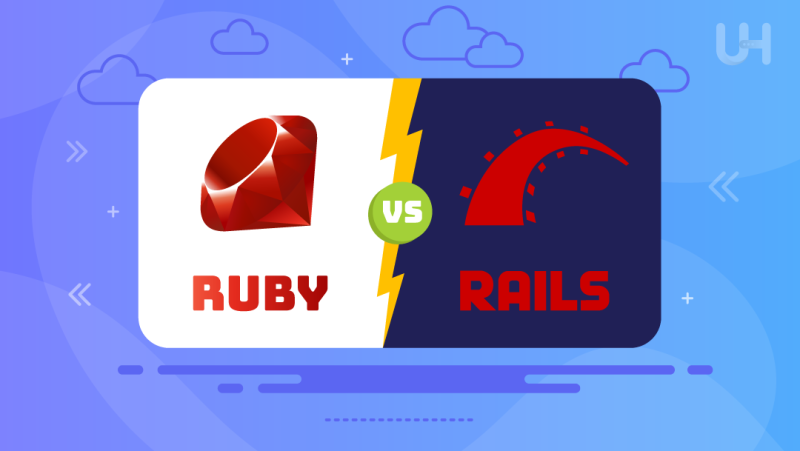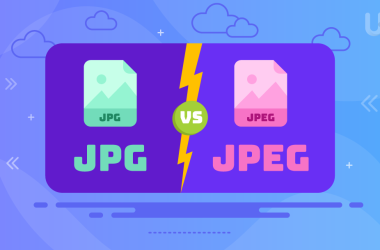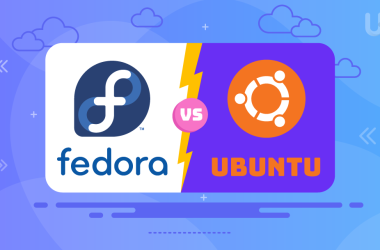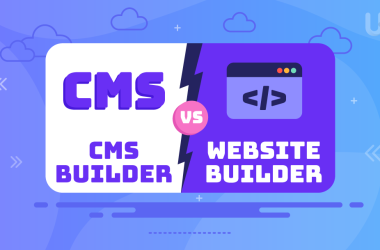Ruby and Ruby on Rails are among the most powerful tools in web development. Both help developers create complex web applications faster. However, the truth is pretty far from what many believe: that one is no different. Understanding the differences between Ruby vs Ruby on Rails is important for anyone who wishes to enter either of these development spaces as a coder, project manager, or a business stakeholder of the project in development.
In this article, we discuss some basic differences between Ruby and Ruby on Rails, indicating their respective merits and demerits. By the end, one should have clear ideas of what each has to offer and how they complement each other in the development world.
What is Ruby?
Ruby is a dynamic, open-source programming language that Yukihiro “Matz” Matsumoto developed in the mid-1990s. The syntax of Ruby has been designed to be as easy to read and write, focusing on simplicity and productivity initially. It is an object-oriented language-that means everything in Ruby is treated as an object, making it very flexible. Ruby attained popularity during the years because of its simplicity and readability; it allowed developers to write concise and readable code.
Ruby is utilized in a variety of general programming tasks that span beyond web development: data processing, automation, and desktop application building are just a few examples. Most of all, Ruby’s syntax is quite human-readable, syntactically, to encourage a natural flow in development and reduce the learning curve.
Advantages
- Readable and Intuitive Syntax: The syntax of Ruby is designed to be as close to natural language as possible. It is simple and effortless to learn and use.
- Dynamic Typing: Ruby is dynamically typed, meaning one can use a variable without declaring and defining its data type. This offers a lot of flexibility and speed on the fly.
- Object-oriented: Ruby sees everything through the lens of objects. This allows for reusable, maintainable, modular code.
- Large Community and Libraries: Ruby has an active community that keeps on writing new libraries (otherwise called gems). Therefore, finding already implemented solutions for common problems is much easier.
- Cross-platform: Ruby can be run on different systems, such as various Linux distributions, MacOS, or Windows, making it compatible with various hosting options, including Windows VPS Hosting and MacOS Servers for users looking to leverage Ruby on a virtual private server.
Disadvantages
- Performance Issues: Ruby is criticized since, compared to languages like C++ or Java, it does not execute as efficiently, especially in CPU-bound tasks.
- Not Ideal for Multithreading: Ruby certainly supports multithreading, but not as powerfully compared to other languages; this might make a difference in high-demand environments.
- Fewer Job Opportunities: This is lesser known to other popular languages like Python or Java, so the job opportunities are relatively fewer as compared to the openings for Ruby developers.
- Memory Usage: Ruby tends to consume quite a lot of memory, especially for large-scale programs.
What is Ruby on Rails?
Ruby on Rails, or simply Rails, is the term used to describe a free, open-source web development framework using a language called Ruby. Developed in 2004 by David Heinemeier Hansson, Rails was built with the convention-over-configuration approach, making developing web applications easier. It has default structures for databases, web pages, and services that speed up the whole process of building web applications.
Ruby on Rails is famous for its “don’t repeat yourself” principle, which means avoiding redundant code, and its emphasis on convention over configuration, whereby the developer follows established conventions to reduce the amount of code he will have to write by hand. Ruby on Rails has been used to develop many high-profile websites and web applications; examples include GitHub, Shopify, and Basecamp.
Advantages
- Rails Rapid Development: Rails is all about speeding up web development by giving you a bunch of tools, libraries, and a very organized workflow that speeds up the coding.
- Convention over Configuration: This principle allows developers to reduce the number of explicit configurations while making simple decisions by using many conventions.
- Scaffolding: Rails provides code generators for scaffolding, which generate code for an app’s basic functionality, allowing the developer to develop an application rapidly.
- Integrated Tests: Rails also offers integrated testing support out of the box. This makes it easy to test your whole application by its Application Programming Interface or UI and structure.
- Large ecosystem: The Rails community has written thousands of gems (libraries) that extend the framework with features such as authentication, file uploading, and background processing.
Disadvantages
- Learning Curve: While Rails speeds up development, much of its convention-over-configuration takes time for a newbie to get used to.
- Performance: Rails are slower than languages with more performant frameworks like Java or C++.
- Large Application Complexity: As applications grow in size and complexity, maintenance is often harder when using Rails, especially without good development practices.
- Server Overhead: Most of the evidence suggests that Rails applications need more server resources to run smoothly for users, particularly compared to frameworks based upon faster low-level languages.
Maximize Your Ruby and Ruby on Rails Projects!
Ready to bring your Ruby or Ruby on Rails applications to life? UltaHost’s dedicated server hosting provides the power and flexibility to support both Ruby scripts and full Rails frameworks. Ensure optimal performance and stability for your web projects.
Ruby vs Ruby on Rails: Differences

While Ruby and Ruby on Rails have almost become synonymous when mentioned together, these two systems focus on very different projects. Understanding the differences between Ruby vs Ruby on Rails is crucial in laying the foundation for development.
Purpose
Ruby is a general-purpose programming language that can be applied in many areas besides web development. Some of the areas where it could be used include scripting, automation, and software development. Given its adaptability, developers can use it for different programming challenges; hence, it is handy in a coder’s toolkit. Ruby is object-oriented, so most developers will build modular codes that can be reused in several projects.
On the other hand, Ruby on Rails is specially designed for web development. The system provides developers with a predefined structure and web development tools for building web applications. Though it is quite possible to develop web apps with Ruby without any framework, Rails saves time by automating much of the work, providing ready-made pieces to fit together, and streamlining the development process. It makes Rails a perfect suit for developers focusing only on web application development.
Flexibility vs Structure
Ruby as a language grants the developer huge flexibility regarding syntax. It doesn’t dictate stringently to you exactly how you should write your code but lets coders have their various style possibilities or approaches. This will help in certain projects where such creative or customized software solutions are needed, with the developer having complete freedom over the architecture and design of their software.
Ruby on Rails, however, relishes its structure. Rails enforce a set of conventions upon the developer using predefined folder structure and naming patterns. This reduces the number of decisions the developer must make but enforces this rigid structure. It cuts down on configuration in Rails, which, along with speeding up development, constrains developers who want to do things their way.
Development Speed
While Ruby is a language of elegance and conciseness in syntax, developing a full-fledged web application with pure Ruby is exhaustive. You write a lot more boilerplate code, have to configure the libraries manually, and handle many things yourself compared to using a web framework. The language is still productive, but it’s not as fast-moving or developer-friendly as the speed and ease of development provided by a framework like Rails.
Ruby on Rails was designed to speed up the development process and provide an automated facility for many of the regular tasks in web application development. The functionality includes scaffolding and form generators to generate common CRUD operations directly without writing code from scratch. That is why startups and businesses normally prefer to prototype or deploy web apps as quickly as possible.
Learning Curve
Ruby has been highly praised for its ease of conception and simplicity, which makes it ideal for beginners. The syntax implemented in this language is natural and very easy to understand. Even a person with zero programming background should be able to understand this language easily. It’s easy to learn the object-oriented principles from Ruby and apply them to developing minimal applications or scripts without hassle. As an independent language, Ruby is intuitive yet accessible.
Rails has a higher learning curve. While the framework simplifies web development, it comes with many conventions and abstractions. These take some time to get used to, particularly by newbies. Besides learning Ruby, a developer has to get used to the conventions, libraries, and best practices that come with Rails. While the payoff in mastering Rails is definitely in productivity, the learning curve at the start may be somewhat uncomfortable for a few beginners because of the new structure and conventions one must adapt to.
Performance
Ruby is a dynamically typed language, thus highly flexible and easy to use, but at a cost. Ruby has always had various performance issues, especially CPU-bound or high application loads. For example, the language is slower than other compiled languages like C++ or Java. Sometimes, it can choke on tasks where much computational power is required. While Ruby is ample for most jobs, it may not be the best choice when discussing high-performance subjects.
Rails borrows performance characteristics from Ruby and has additional overhead as a web framework. However, it does particularly well at getting the product done quickly. Regarding actual raw speed, the applications seem inherently incapable of low latency or volume. If you’re doing performance-sensitive work, carefully optimize both Ruby and Rails or use other frameworks built on faster languages.
Community and Ecosystem
Ruby has a vast and enthusiastic community and many libraries, tools, and other resources called gems. Gems extends Ruby’s capabilities beyond the core to help developers integrate third-party support for file handling, networking, and automation. This ecosystem makes Ruby versatile and well-supported in several development environments.
Ruby on Rails, developed atop Ruby, shared the same committed community but had its ecosystem particularly tailored for web development. The Rails community developed various gems for solving web development needs: authentication, payment gateways, and API integrations. Reciprocally, with Rails, all those libraries can be rapidly implemented into applications. This makes it a powerful choice for web development projects.
Comparison Table
Here’s a comparison table that concisely highlights the key differences between Ruby vs Ruby on Rails:
| Aspect | Ruby | Ruby on Rails |
| Type | General-purpose programming language | Web application framework built on Ruby |
| Primary Use | Scripting, automation, software development | Web application development |
| Flexibility | Highly flexible, multiple coding styles | Follows strict conventions (Convention-over-Configuration) |
| Learning Curve | Easy to learn with simple, readable syntax | Steeper learning curve due to conventions and complexity |
| Development Speed | Slower for web apps without a framework | Fast development with built-in tools and libraries |
| Performance | Moderate performance for most tasks | Can be slower due to overhead in large web apps |
| Community Support | Large, active community with numerous gems | Shares Ruby’s community, with added focus on web development gems |
| Scalability | Suitable for small to medium applications | Better for rapid development but can become complex in large apps |
| Ideal For | General-purpose programming, scripting | Fast web application development, prototyping |
Conclusion
Ruby and Ruby on Rails are two different yet complementary software tools. One is a flexible programming language intended to suit many types of software development, while the other is actually designed as a framework to speed up web development. Together, they create a powerful ecosystem for modern web application development, and understanding these differences would make it work effectively.
When choosing between Ruby vs Ruby on Rails for web development, pairing them with reliable web hosting solutions like UltaHost is essential to ensure optimal performance and scalability. UltaHost provides speed, security, and seamless deployment for your projects.
FAQ
What is Ruby?
Ruby is a dynamic, object-oriented programming language known for its simplicity and readability.
What is Ruby on Rails?
Ruby on Rails is a web development framework built using Ruby that simplifies building web applications.
Can Ruby be used without Ruby on Rails?
Yes, Ruby can be used for tasks beyond web development, such as scripting, automation, and software creation.
What’s the main difference between Ruby vs Ruby on Rails?
Ruby is a programming language, while Ruby on Rails is a web development framework built using Ruby.
Is Ruby on Rails faster to learn than Ruby?
No, Ruby is easier to learn. Rails’s learning curve is steeper due to its conventions and web-specific tools.
Is Ruby slower than other programming languages?
Yes, Ruby is often considered slower than languages like Java or C++, especially in performance-intensive tasks.
Which should I learn first, Ruby or Ruby on Rails?
It’s best to start with Ruby to understand the language before diving into the Ruby on Rails framework.












